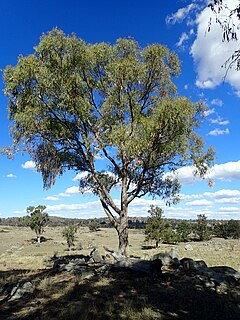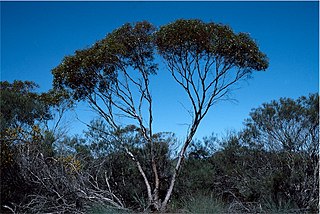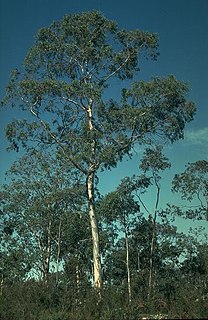
Eucalyptus nova-anglica, commonly known as the New England peppermint or black peppermint, is a species of small to medium-sized tree endemic to eastern Australia. It has thick, rough, fibrous bark on the trunk and larger branches, lance-shaped adult leaves, flower buds in groups of seven, white flowers and hemispherical or conical fruit.

Eucalyptus radiata, commonly known as the narrow-leaved peppermint or Forth River peppermint, is a species of tree that is endemic to south-eastern Australia. It has rough, fibrous to flaky bark on the trunk and larger branches, smooth grey bark on the thinner branches, lance-shaped to curved or almost linear leaves, flower buds in groups of eleven to twenty or more, white flowers and cup-shaped, hemispherical or shortenend spherical fruit.

Eucalyptus horistes is a species of mallee or small tree that is endemic to Western Australia. It has smooth greyish bark, often with rough, firm fibrous bark on the base or all of the trunk, lance-shaped to elliptic adult leaves, flower buds in groups of between seven and thirteen, creamy white flowers and short cylindrical to shortened spherical fruit.
Eucalyptus nitida, commonly known as the Smithton peppermint, is a species of tree or mallee that is endemic to Tasmania. It has varying amounts of loose, fibrous or flaky bark, lance-shaped to curved adult leaves, flower buds in groups of nine to fifteen, white flowers and cup-shaped to hemispherical fruit.

Eucalyptus tenuiramis, commonly known as the silver peppermint, is a species of small to medium-sized tree that is endemic to southeastern Tasmania. It has smooth bark, broadly lance-shaped adult leaves, flower buds in groups of nine to fifteen, white flowers and cup-shaped, hemispherical or conical fruit.
Corymbia papuana, commonly known as ghost gum, is a species of evergreen tree native to New Guinea, some Torres Strait Islands and the northern part of the Cape York Peninsula in Australia. It has smooth whitish bark, lance-shaped adult leaves, flower buds in groups of three or seven, creamy white flowers and barrel-shaped or urn-shaped fruit.
Eucalyptus croajingolensis, commonly known as the East Gippsland peppermint or Gippsland peppermint, is a species of tree that is endemic to southeastern Australia. It has rough, short-fibrous bark on the trunk and larger branches, sometimes smooth bark on the thinner branches, lance-shaped to curved adult leaves, flower buds in groups of nine or more, white flowers and hemispherical to cup-shaped fruit.

Eucalyptus brachyandra, commonly known as the tropical red box, is a straggly tree, mallee or shrub and is endemic to north-western Australia. It has rough, fibrous to stringy bark on the trunk and smooth grey to white bark on the smaller branches. Mature trees have elliptic to oblong or egg-shaped leaves, tiny flower buds in groups of three or seven, creamy white flowers and cup-shaped, bell-shaped or urn-shaped fruit. It grows in the Kimberley region of Western Australia and the Top End of the Northern Territory.
Eucalyptus calyerup is a tree that is endemic to a small area in the south-west of Western Australia. It has rough, fibrous bark on the lower part of the trunk, smooth bark above, elliptic to lance-shaped adult leaves, flower buds in groups of seven, creamy-yellow flowers and conical to bell-shaped fruit.
Eucalyptus obesa, commonly known as the Ninety Mile Tank mallee, is a species of mallee that is endemic to Western Australia. It has smooth, greyish to pale brown bark, usually lance-shaped adult leaves, flower buds in groups of between eleven and fifteen, creamy white flowers and shortened spherical to hemispherical fruit.

Corymbia gilbertensis, commonly known as the Gilbert River ghost gum or Gilbert River box, is a species of tree that is endemic to tropical far north Queensland. It has rough, tessellated bark on the lower part of the trunk, smooth bark above, a crown of juvenile, intermediate and adult leaves, flower buds mostly in groups of seven, creamy white flowers and cup-shaped to barrel-shaped fruit.

Corymbia jacobsiana, commonly known as Jacob's bloodwood or the stringybark bloodwood, is a species of tree that is endemic to the Northern Territory. It has rough, stringy bark on the trunk and branches, lance-shaped to elliptical or curved adult leaves, flower buds in groups of three or seven, creamy white flowers and urn-shaped fruit.

Eucalyptus falciformis, commonly known as the Grampians peppermint or western peppermint, is a species of tree or mallee that is endemic to south eastern Australia. It has smooth bark, sometimes with rough, fibrous bark at the base, narrow lance-shaped to egg-shaped or curved adult leaves, flower buds in groups of eleven to twenty one, white flowers and cup-shaped to shortly cylindrical fruit.

Eucalyptus captiosa is a species of mallee that is endemic to the south-west of Western Australia. It has smooth bark, lance-shaped adult leaves, groups of three or seven, slightly ribbed flower buds arranged in leaf axils, pale yellow flowers and cup shaped fruit.
Eucalyptus costuligera is a species of small tree that is endemic to the Kimberley region of Western Australia. It has short-fibrous or flaky bark on the trunk and branches, bluish, lance-shaped adult leaves, club-shaped flower buds in branched or unbranched inflorescences with the buds in groups of up to seven, creamy-white flowers and conical, cup-shaped or pear-shaped fruit.

Eucalyptus discreta is a species of shrub or mallee that is endemic to Western Australia. It has smooth creamy brown and pale grey bark, narrow-lance-shaped adult leaves, flower buds in groups of seven or nine, creamy-white flowers and barrel-shaped fruit.

Eucalyptus willisii, also known as shining peppermint or promontory peppermint, is a species of small to medium-sized tree, sometimes a mallee that is endemic to Victoria, Australia. It has rough, fibrous bark on the trunk and branches, lance-shaped to curved adult leaves, flower buds in groups of eleven to twenty five, white flowers and cup-shaped or hemispherical fruit.
Eucalyptus minniritchi is a species of multi-stemmed, spreading mallee that is endemic to Central Australia. It has glossy, brown to grey, "minni ritchi" bark on the trunk, elliptical to egg-shaped adult leaves, flower buds mostly in groups of seven, pale creamy yellow flowers and conical to hemispherical fruit.
Eucalyptus ornans, commonly known as Avon peppermint, is a species of mallee that is endemic to a restricted area in Victoria. It has smooth whitish to grey bark, slightly glossy, bluish green, lance-shaped adult leaves, flower buds in groups of between seventeen and twenty one, white flowers and shortened hemispherical fruit.
Eucalyptus rodwayi, commonly known as the swamp peppermint, is a species of small to medium-sized tree that is endemic to Tasmania. It has rough, fibrous to flaky bark on the trunk and branches, narrow lance-shaped adult leaves, flower buds in groups of between seven and eleven, white flowers and conical to hemispherical fruit.










